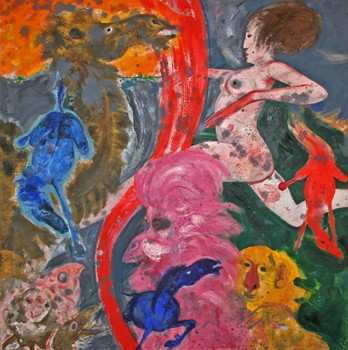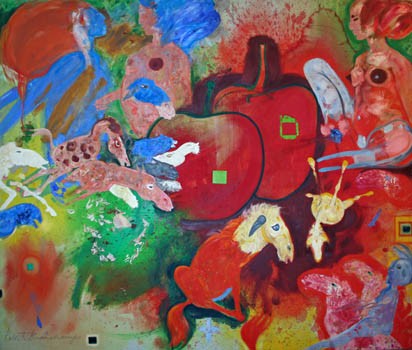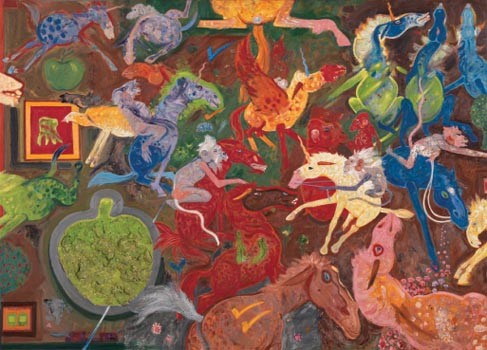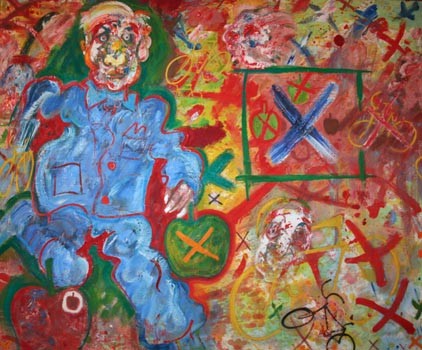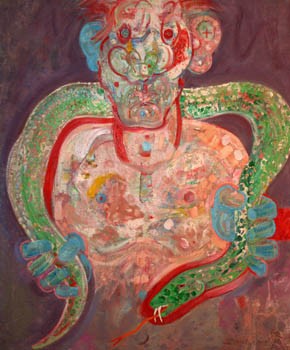Robert Beauchamp's Animalia
ACME Fine Art in Boston
By: Adam Zucker - Dec 17, 2009
ACME Fine Art38 Newbury Street, 4th Floor
Boston, MA
October 30th - December 23rd, 2009
Robert Beauchamp (1923-1995) was a master painter and throughout his career his paintings reflected the artists' growth as both an artist and a humanist visionary. Robert Beauchamp: Animalia at ACME Fine Art on Boston's Newbury Street selects works from the artists' massive oeuvre that reveal Beauchamp's interest with the animal kingdom. The work in this exhibition encompasses the periods between 1965 and 1990.
Beauchamp's early work established him as an important Figurative Expressionist, a movement that emerged from Abstract Expressionism. His early paintings contain all of the basic tenants of modernist mastery, some of which was imparted to him by the great teacher/artist Hans Hofmann. However, while Hofmann's method of teaching focused on non-representational formalism, during the mid-fifties some of his students including Beauchamp, Jan Muller, Lester Johnson, and George McNeil, abandoned abstraction to develop figural formalism.
Towards the end of the 50's more and more young artists both in Provincetown and New York City started to paint in this mode. Their artwork became more indicative of an emotional response to the colletive experience of the world around them, than the abstract constructs. However, many critics who were heavily influenced by the outspoken force that was Clement Greenberg, naively ignored this movement.
Instead of receiving their credit as revolutionary modernists, the East Coast Figurative Expressionists were overshadowed by their Ab Ex contemporaries and superseded by Pop Art and Minimalist art in the sixties. However, it is clear when looking at the vast body of work that Beauchamp and his contemporaries created throughout the sixties and seventies, and into the last decade of the 20th century; the Figurative Expressionists were the last great American modernist painters.
In the work from the late 50's, 60's, and 70's, Beauchamp's figurations contort and dance around the canvas. Viewers enter a world of mystical imagination both primitive and intellectual, where yearning for an extreme realm of otherworldly existence is stimulated. His blending of the figure and the ground and his gestural application of paint show that Beauchamp mastered Hofmann's Push and Pull technique, as well as the action painting process that critic Harold Rosenberg coined to associate with Abstract Expressionists. In the last two decades of his life, Beauchamp began to express the human figure in a very distinct and more blatantly personal manner than previously. His progression showed that as an artist he remained responsive at all times. Beauchamp is a testament that expression and emotion, both experienced and imagined, are most powerful when they arise out of the spontaneous application of paint.
His subjects including horses, birds, monkeys, bulls, camels, and female nudes (and humanoids that blur the line between real life and fantasy creatures), remained a recurring element in his figurations. This is seen in the earliest examples from the exhibition, Three Persona's: Women, Witch and Harpy (c. 1965) and Untitled (c. 1969). In the seventies he started to paint apples into the swirling landscapes of animal and humanoid imagery. Two Apples (1970) and Untitled (c. 1970) are the largest and vivacious of the paintings. These figurations remained fairly consistent until the 1980's. During the 80's, Beauchamp became focused on painting self-portraits or portraits that rendered the figure in a very poignant fashion. Man In Blue (1982) is a painting that transitions his 70's imagery of apples into the new subject matter. The main figuration is painted coming out of the left edge of the canvas. He is in a dense field of color, apples, x's, and bicycles. The figures in works like Untitled #7 (1982) and Self Portrait and Snake (1983) are frontal and extremely moving.
As far as thematic surveys go, the exhibition at ACME is a great example of Beauchamp's creative process over 40 years. While this is just a select sample of a prolific ouvre, Animalia is an important spectrum of works by a seminal American painter.


